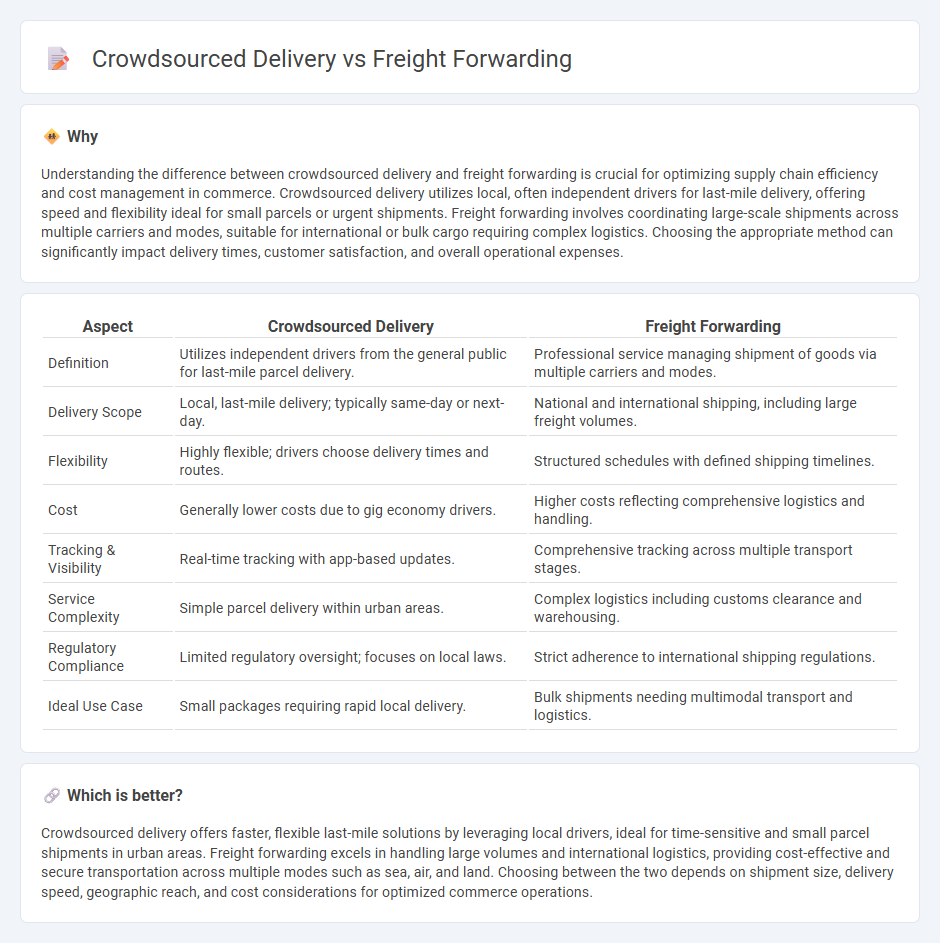
Crowdsourced delivery leverages local individuals and gig workers to provide fast, flexible, and cost-effective parcel transport, optimizing last-mile logistics. Freight forwarding involves professional intermediaries managing complex international shipments, coordinating multiple carriers to ensure efficient cargo movement across borders. Discover more about how each method transforms commerce logistics and delivery efficiency.
Why it is important
Understanding the difference between crowdsourced delivery and freight forwarding is crucial for optimizing supply chain efficiency and cost management in commerce. Crowdsourced delivery utilizes local, often independent drivers for last-mile delivery, offering speed and flexibility ideal for small parcels or urgent shipments. Freight forwarding involves coordinating large-scale shipments across multiple carriers and modes, suitable for international or bulk cargo requiring complex logistics. Choosing the appropriate method can significantly impact delivery times, customer satisfaction, and overall operational expenses.
Comparison Table
| Aspect | Crowdsourced Delivery | Freight Forwarding |
|---|---|---|
| Definition | Utilizes independent drivers from the general public for last-mile parcel delivery. | Professional service managing shipment of goods via multiple carriers and modes. |
| Delivery Scope | Local, last-mile delivery; typically same-day or next-day. | National and international shipping, including large freight volumes. |
| Flexibility | Highly flexible; drivers choose delivery times and routes. | Structured schedules with defined shipping timelines. |
| Cost | Generally lower costs due to gig economy drivers. | Higher costs reflecting comprehensive logistics and handling. |
| Tracking & Visibility | Real-time tracking with app-based updates. | Comprehensive tracking across multiple transport stages. |
| Service Complexity | Simple parcel delivery within urban areas. | Complex logistics including customs clearance and warehousing. |
| Regulatory Compliance | Limited regulatory oversight; focuses on local laws. | Strict adherence to international shipping regulations. |
| Ideal Use Case | Small packages requiring rapid local delivery. | Bulk shipments needing multimodal transport and logistics. |
Which is better?
Crowdsourced delivery offers faster, flexible last-mile solutions by leveraging local drivers, ideal for time-sensitive and small parcel shipments in urban areas. Freight forwarding excels in handling large volumes and international logistics, providing cost-effective and secure transportation across multiple modes such as sea, air, and land. Choosing between the two depends on shipment size, delivery speed, geographic reach, and cost considerations for optimized commerce operations.
Connection
Crowdsourced delivery leverages decentralized, on-demand networks of independent drivers to transport goods efficiently, while freight forwarding coordinates the complex logistics of moving large shipments across multiple carriers and borders. Both systems optimize supply chain operations by enhancing flexibility, reducing delivery times, and lowering costs through technology-driven tracking and route management. Integration of crowdsourced delivery within freight forwarding accelerates last-mile delivery, improving overall customer satisfaction in e-commerce and global trade.
Key Terms
Logistics
Freight forwarding involves managing shipments through established transport networks, ensuring cargo moves efficiently via air, sea, or land with professional oversight and customs clearance. Crowdsourced delivery leverages a network of independent drivers using their vehicles to handle last-mile logistics, offering faster and flexible solutions for smaller parcels in urban areas. Explore the advantages and applications of both methods to optimize your logistics strategy.
Third-party service
Third-party freight forwarding services utilize established logistics networks to manage cargo efficiently, ensuring reliability and compliance with international shipping regulations. Crowdsourced delivery leverages a distributed network of independent drivers through digital platforms to provide flexible, cost-effective last-mile services. Explore the advantages and applications of these third-party solutions to determine the best fit for your supply chain needs.
Shipment tracking
Freight forwarding leverages advanced shipment tracking systems using GPS and RFID to provide real-time updates throughout the supply chain, ensuring high accuracy and reliability for large-scale shipments. Crowdsourced delivery employs mobile app-based tracking, offering flexible, last-mile visibility but may lack the comprehensive monitoring capabilities found in traditional freight forwarding. Explore the differences in shipment tracking technologies and choose the best solution for your logistics needs.
Source and External Links
What is freight forwarding? | Clarksons - Freight forwarding involves planning and coordinating the international movement of goods across air, sea, rail, or road, with freight forwarders acting as intermediaries managing logistics, customs clearance, and transport arrangements on behalf of clients to ensure timely and efficient delivery.
About Freight Forwarding - FIATA - Freight forwarding facilitates international trade by ensuring goods are moved from origin to destination on time, in good condition, and at the most economical cost, providing services such as carriage, consolidation, storage, customs handling, insurance, and supply chain management.
What Is Freight Forwarding? Definition, Benefits and Key Stages - The freight forwarding process includes export haulage, export customs clearance, and origin handling, involving inspection and compliance checks to safely and legally move shipments internationally, with attention to regulated and sensitive goods categories.
 dowidth.com
dowidth.com